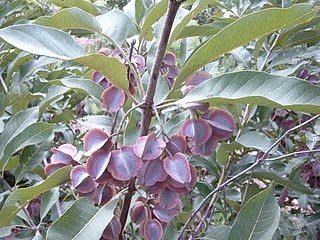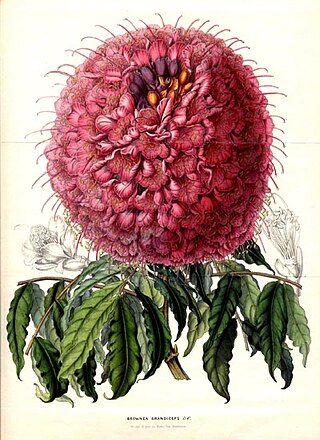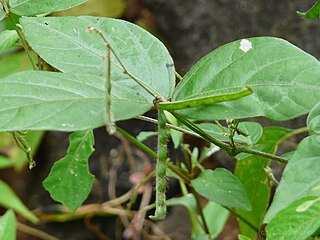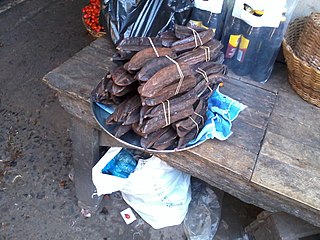
Pterocarpus is a pantropical tree genus in the Fabaceae family. It belongs to the subfamily Faboideae, and was recently assigned to the informal monophyletic Pterocarpus clade within the Dalbergieae. Most species of Pterocarpus yield valuable timber traded as padauk, usually pronounced or ; other common names are mukwa or narra.

Abrus is a genus of flowering plants in the pea family, Fabaceae, and the only genus in the tribe Abreae. It contains 13–18 species, but is best known for a single species: jequirity. The highly toxic seeds of that species are used to make jewellery.

Brachystegia is a genus of tree of the subfamily Detarioideae that is native to tropical Africa.

Combretum, the bushwillows or combretums, make up the type genus of the family Combretaceae. The genus comprises about 272 species of trees and shrubs, most of which are native to tropical and southern Africa, about 5 to Madagascar, but there are others that are native to tropical Asia, New Guinea and the Bismarck Archipelago, Australia, and tropical America. Though somewhat reminiscent of willows (Salix) in their habitus, they are not particularly close relatives of these.

Sesbania is a genus of flowering plants in the pea family, Fabaceae, and the only genus found in tribe Sesbanieae. Riverhemp is a common name for plants in this genus. Notable species include the rattlebox, spiny sesbania, and Sesbania sesban, which is used in cooking. Plants of this genus, some of which are aquatic, can be used in alley cropping to increase the soil's nitrogen content. The species of rhizobia responsible for nitrogen fixation in Sesbania rostrata is Azorhizobium caulinodans.

The subfamily Detarioideae is one of the subdivisions of the plant family Fabaceae (legumes). This subfamily includes many tropical trees, some of which are used for timber or have ecological importance. The subfamily consists of 84 genera, most of which are native to Africa and Asia. Pride of Burma and tamarind are two of the most notable species in Detarioideae. It has the following clade-based definition:
The most inclusive crown clade containing Goniorrhachis marginataTaub. and Aphanocalyx cynometroidesOliv., but not Cercis canadensisL., Duparquetia orchidaceaBaill., or Bobgunnia fistuloides(Harms) J. H. Kirkbr. & Wiersema.
Bussea is a genus of flowering plants in the legume family, Fabaceae. It includes seven species of trees and occasionally shrubs native to sub-Saharan Africa, ranging from Guinea to Ghana in West Africa, from Gabon and Angola to Tanzania and Mozambique in central Africa, and to Madagascar. Habitats include seasonally-dry tropical forests and thickets, moist semi-deciduous forests, and evergreen rain forest.

Dialium is a genus of flowering plants in the family Fabaceae, subfamily Dialioideae. Velvet tamarind is a common name for several species. The genus includes 37 species which range from the tropical Americas to sub-Saharan Africa, Madagascar, India, Indochina, and western Malesia.

Schefflerodendron is a genus of flowering plants in the family Fabaceae. It includes four species of trees native to tropical Africa, ranging from Cameroon to Tanzania and Angola. They grow in tropical rain forest and seasonally-dry forest, including disturbed areas. Three species are native to the Guineo-Congolian forests of west-central Africa, and one species also extends to the Zanzibar-Inhambane coastal forests of Tanzania.
Tetraberlinia is a genus of plants in the legume family, Fabaceae. It includes species of trees native to west and west-central tropical Africa, including Liberia, Cameroon, Equatorial Guinea, Gabon, Republic of the Congo, Cabinda, and DR Congo. They grow in tropical lowland rain forest and riverine forest, often forming monodominant stands.
Zenkerella is a genus of plants in the family Fabaceae. It includes six species of evergreen trees native to tropical Africa. One species is native to Nigeria, Cameroon, and Gabon in west-central tropical Africa, where it grows in lowland, riverine, or swamp Guineo-Congolian forest. The other five species grow in Afromontane or coastal Zanzibar–Inhambane forest in Tanzania.

Griffonia is a genus of central African flowering plants in the legume family, Fabaceae. It belongs to the subfamily Cercidoideae. Griffonia is known to have a high concentration of 5-HTP in its seeds.

Leptoderris is a genus of flowering plants in the family Fabaceae. It includes 22 species native to tropical Africa, ranging from Senegal to Tanzania, Malawi, Zambia, and Angola. It belongs to the subfamily Faboideae.

Physostigma is a genus of flowering plants in the family Fabaceae. It includes five species of erect or climbing herbs and subshrubs native to sub-Saharan Africa. They grow in tropical swamp and riverine vegetation and seasonally-dry forest, open woodland, and grassland in the Guineo-Congolian and Zambezian regions. The genus belongs to subfamily Faboideae.
Pseudoeriosema is a genus of flowering plants in the legume family, Fabaceae. It includes five species of herbs or shrubs native to tropical Africa. Typical habitats include seasonally-dry tropical woodland, wooded grassland, and seasonally swampy grassland in the Zambezian, Sudanian, and Somali-Masai regions. It belongs to subfamily Faboideae.

Teramnus is a genus of flowering plants in the legume family, Fabaceae. It includes eight species of climbing herbs and subshrubs native to the tropics of the Americas, sub-Saharan Africa, the Arabian Peninsula, the Indian Subcontinent, Indochina, Hainan, Taiwan, and New Guinea. Typical habitats are seasonally-dry tropical bushland and thicket, grassland, wooded grassland, and forest clearings, often in open and dry rocky areas.

Tetrapleura is a genus of flowering plants in the mimosoid clade of the family Fabaceae. It includes two species of trees native to sub-Saharan Africa, ranging from Senegal to Kenya and Tanzania, and south to Angola. They grow in tropical lowland rain forest, secondary thicket, and fringing forest in the Guineo-Congolian forest and Lake Victoria basin.

Philenoptera is a genus of flowering plants in the legume family, Fabaceae. It includes 11 species of trees, shrubs, and more rarely lianas native to sub-Saharan Africa. Typical habitats include seasonally-dry tropical forest, woodland, wooded grassland, and bushland. Four species are native to the Zambezian region, 3 species to the Sudanian region, 2 species to the Zanzibar-Inhambane and Tongaland-Pondoland regions, 1 species to the Somali-Masai region, 1 species to the Guineo-Congolian region, and 1 to Madagascar.

Deinbollia is a genus of flowering plants belonging to the family Sapindaceae.















